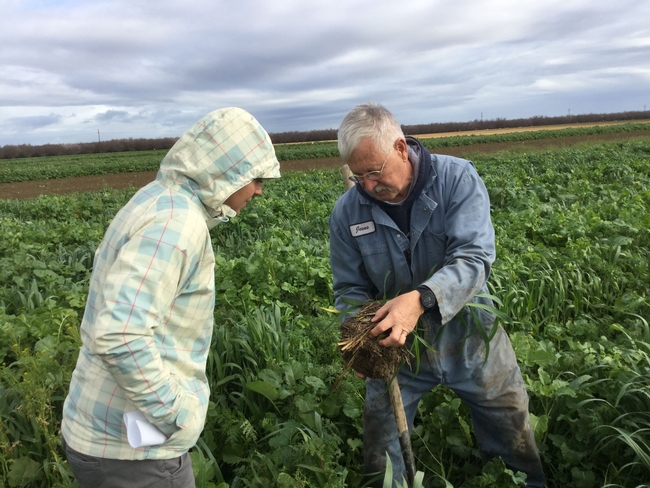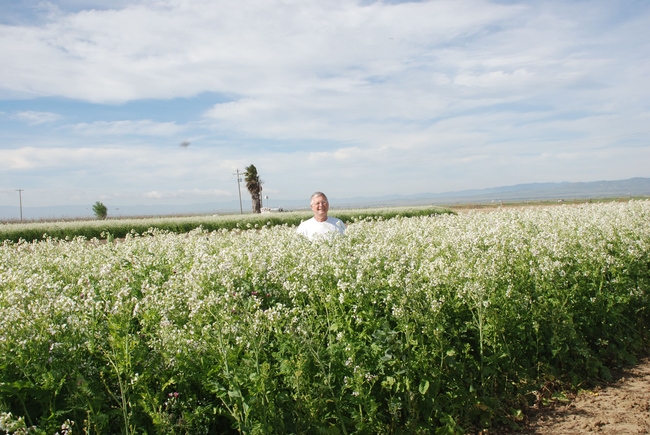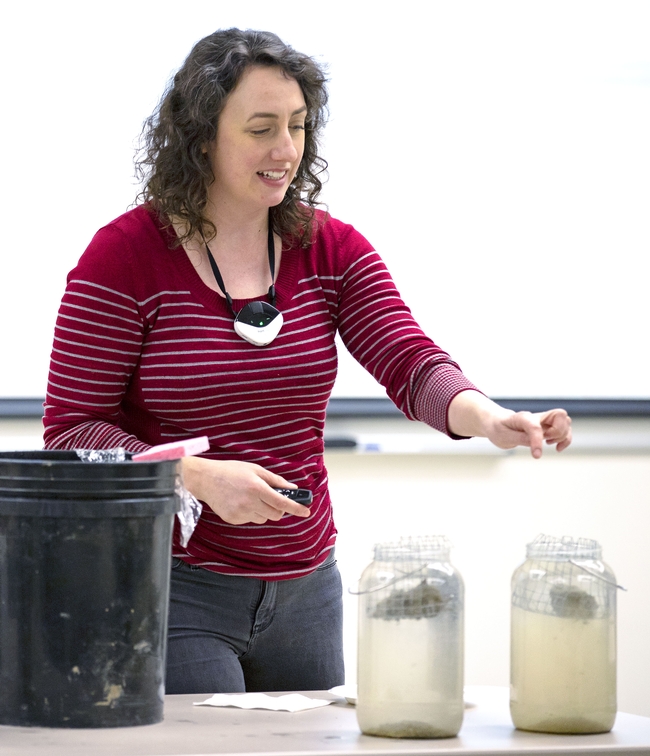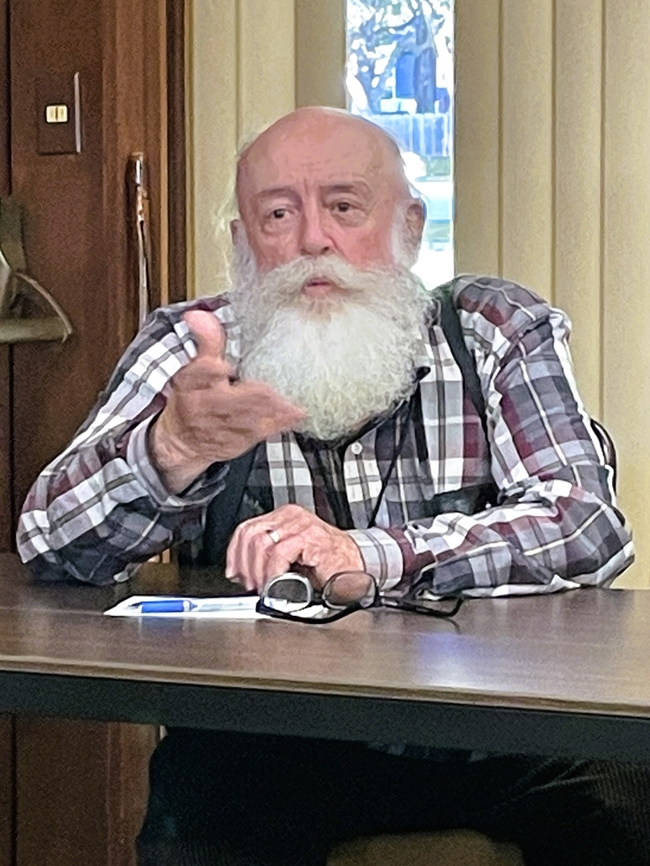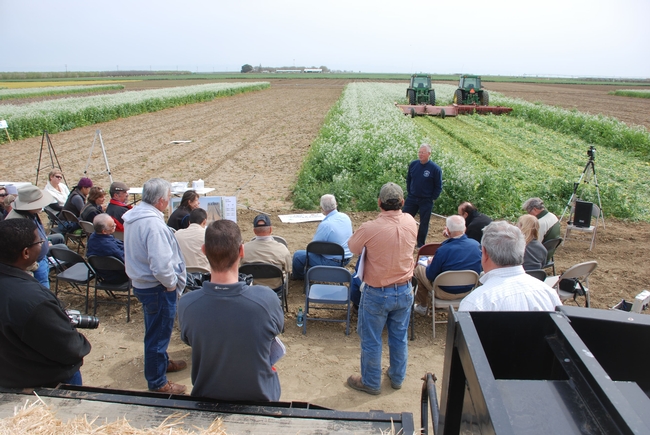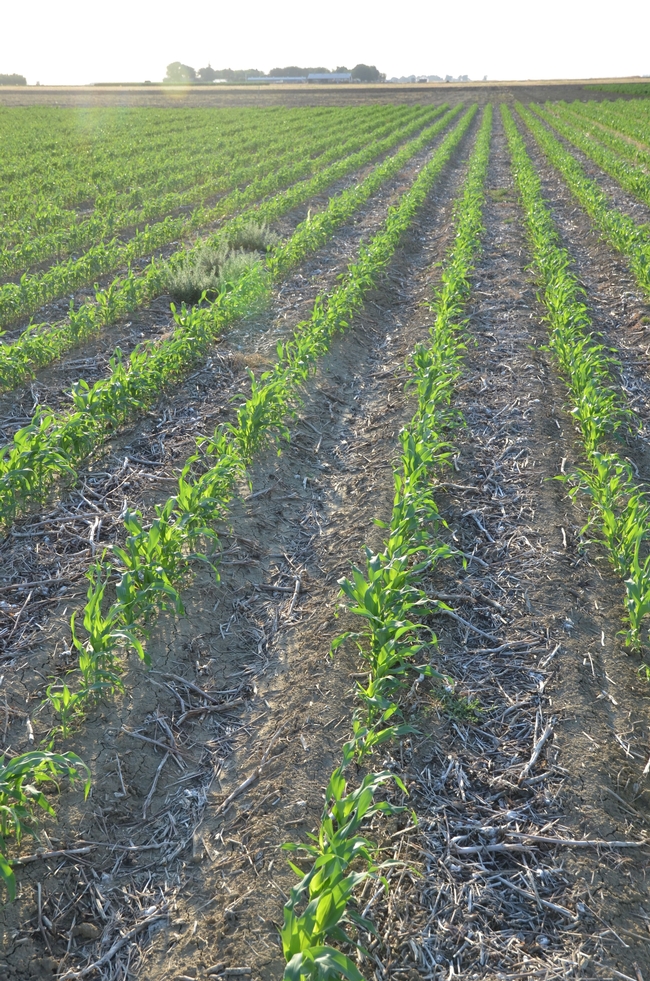Posts Tagged: Jeff Mitchell
Lawn-pocalypse! Surviving Drought
Ah, summer! The season of sunburns, pool parties, and… lawn droughts. If your once lush, green carpet now looks like a crunchy brown doormat, you're not alone. Let's dive into why your yard is staging a dramatic death scene and what you can do to...

Bermuda grass and weeds overtaking drought stressed turf grass.
West Side REC study: A cradle of California regenerative agriculture
In 20-year study, UCCE specialist Mitchell, colleagues, growers advance no-till and cover cropping practices
In the 1990s, long before “regenerative agriculture” was a buzzword and “soil health” became a cause célèbre, a young graduate student named Jeff Mitchell first learned about similar concepts during an agronomy meeting in the Deep South.
Mitchell was astonished to hear a long list of benefits attributed to practices known internationally as “conservation agriculture” – eliminating or reducing tillage, cover cropping and preserving surface residues (the plant debris left after harvest). Potential positive impacts include decreasing dust in the air, saving farmers money on fuel and equipment maintenance, improving soil vitality and water dynamics and a host of other ecosystem services.
“All of these things start adding up and you kind of scratch your head and say, ‘Well, maybe we ought to try some of this,'” recalled Mitchell, who became a University of California Cooperative Extension cropping systems specialist at UC Davis in 1994.
In 1998, Mitchell launched a long-term study of those practices at the West Side Research and Extension Center (REC) in Five Points, Fresno County. “We started this because, way back when I first began my job, nobody was doing this,” he explained. “This was brand-new, uncharted territory for California.”
For the next 20 years, Mitchell and his colleagues studied changes to the soil and ecosystem, learned from their failures and successes, and shared those hard-won lessons with fellow scientists and farmers across the state. A summary of their findings was recently published in the journal California Agriculture.
Conservation agriculture in California: ‘No trivial undertaking'
Mitchell and the Conservation Agriculture Systems Innovation Workgroup – a network established in 1998 comprising farmers, researchers, public agency personnel and members of private entities and environmental groups – started with a virtually blank slate. According to Mitchell, surveys at the beginning of the 21st century found that conservation agriculture practices were used on less than one-half of 1% of annual crop acreage in California.
Although no-till is common in the Midwest and Southeast of the U.S. and across wide swaths of the globe, it was almost unheard of in the Golden State. With the development of irrigation infrastructure in the 1920s, California farmers saw continually phenomenal growth in yield over the last century – and thus had little incentive to deviate from tried-and-true methods that relied on regular tillage.
Nevertheless, intrigued by the potential benefits of conservation agriculture, Mitchell wanted to see which of those practices could be feasibly applied to California cropping systems. During the 20-year study at West Side REC, the researchers grew a rotation of cotton-tomato, followed by a rotation of garbanzo, melons, and sorghum, and finally tomatoes.
But at first, it was a struggle to grow anything at all – as they had to master the basics of how to establish the plants in a no-till, high-residue system.
“This was no trivial undertaking,” Mitchell said. “Early on we struggled – we failed the first couple of years because we didn't know the planting techniques and we had to learn those. There was an upfront, very steep learning curve that we had to manage and overcome.”
Then there was the long wait to see any measurable improvements to soil health indicators, such as the amount carbon in the soil.
“For the first eight years, we didn't see any changes whatsoever,” Mitchell said. “But then they became strikingly different, between the no-till cover crop system and the conventional field without cover crops, and the divergence between those two systems became even starker.”
The two-decade time horizon for the West Side REC study is one major reason why it has been so valuable for growers and scientists alike.
“It's so hard to capture measurable changes in soil health and soil function metrics through research because those changes are really slow,” said Sarah Light, UCCE agronomy farm advisor for Sutter, Yuba and Colusa counties and a co-author of the recent California Agriculture paper. “Often in the course of a three-year grant you don't actually get statistically significant differences.”
Reaching, teaching and learning from farmers
The study site on the west side of the San Joaquin Valley also has been a vital teaching resource. Even though Light works with farmers in the Sacramento Valley, she has conveyed findings from that research with her clientele and uses soil samples from the site to vividly illustrate a significant benefit of conservation agriculture practices.
In one demonstration, she drops soil aggregates – which look like clumps of soil – into two containers of water. One clump, from heavily tilled land, falls apart quickly and the water becomes dark and murky. The other, comprised of soil that has been no-till and cover cropped for 20 years, holds together – a sign of healthy, resilient soil – and the water remains relatively clear.
“It's a really simple demo, but it's very effective because it shows how easily soil aggregates break apart with water – or not,” Light said.
That aggregate stability is a key factor in soil's ability to both move water (infiltration) and hold onto water (retention). Those dynamics are crucial for farmers to avoid ponding in their fields, preserve water for drier months, and generally endure the flood/drought whiplash of climate change.
Over the years, Mitchell has hosted thousands of visitors at the West Side REC study site to showcase the potential benefits of adopting soil-health management practices.
“I don't think I'm exaggerating in saying that this is probably the most-visited agricultural field station project in the history of UC ANR (UC Agriculture and Natural Resources),” he said.
Both the West Side REC – and Mitchell himself – are greatly valued by the local grower community.
“Jeff is a microcosm of the university's applied research on the West Side of the San Joaquin Valley,” said John Diener, who grows almonds, fresh market garlic, canning tomatoes, cotton, masa corn and wheat for production and seed on land adjacent to the field station.
Growers adopt, adapt and adjust practices
Tom Willey, a retired farmer and longtime collaborator with Mitchell, has actively encouraged peers to visit the Five Points site – especially in the early years.
“It was very innovative and there weren't many examples of that anywhere in the state,” Willey said. “So, I helped encourage people to go out there and learn and possibly think about doing similar work on their own farms.”
Willey himself was a pioneer in experimenting with no-till practices in organic vegetable cropping systems.
“As organic farmers, we were probably more tillage dependent than conventional farmers because it was the only method we had for weed control; we weren't able to use herbicides,” Willey said.
Despite early struggles, he persisted in trying different techniques and mechanical means of weeding. And Willey later partnered with a group of progressive vegetable growers and UC and California State University Chico personnel to secure a Conservation Innovation Grant from the Natural Resources Conservation Service to support more on-farm trials and share their experiences.
In the end, however, no-till proved too risky to continue, given the losses they incurred. One tricky issue is nutrient cycling. The organic growers found that after mowing down a cover crop and spreading compost, leaving those nutrients on the surface without incorporating into the soil through more vigorous tilling (or adding synthetic fertilizers, as conventional growers could do) results in lower yields. In the short term, farmers simply did not see yields that could sustain their operation.
“It's very difficult in vegetable systems, and particularly difficult in organic vegetable systems,” Willey said. “I would say a number of us have learned to diminish the over-reliance that we had on tillage, but not to completely eliminate it.”
Cover cropping is also a challenge for some farmers, with certain cover crops making a perfect haven for devastating pests such as lygus bugs and stink bugs, according to Diener.
“We do everything we can to eliminate the host crop from which they come, so why am I going to bring the enemies to my house?” he said. “It's about making enough money to be there next year. You're not going to be there next year with these pests. It's just not a practical management option, in light of our significant pest pressure and disease hosts for our crops of value.”
Instead of planting cover crops, Diener said he opts for mixing in grain crops that can similarly contribute to soil health – while generating revenue at the same time. According to Diener, a longtime collaborator with Mitchell, the best way to adopt conservation agriculture practices is to tailor them to specific localities and each grower's circumstances. And in his corner of the San Joaquin Valley, that means not following the template of the high-precipitation, no-till systems found in the Midwest.
“We've adapted Jeff's principles to our program; it won't look like Iowa to you, which is what everybody comes to expect to see. It ain't how it works, folks,” Diener said. “It's a different methodology. We do those things that fit our environment and that's why that West Side field station is important – because it's our environment.”
Promoting and enhancing soil health, one step at a time
More widespread adoption of soil-health management practices can be driven by a variety of factors. With the rise of drip irrigation in tomatoes, for example, more growers began using no-till or reduced till to minimize disruptions to the delicate driptape in their fields.
And, according to Mitchell, the dramatic increase in no-till practices in dairy silage production – from less than 1% to over 40% – was the result of entrepreneurial efforts by a small but extraordinarily dedicated group from the private sector that worked with farmers, one by one.
Because optimizing these practices requires close and intensive attention – and no small amount of courage and gumption – Mitchell and Light understand that growers might need to take an incremental approach. Even one fewer pass over the field, or cover cropping every other year, can provide some benefit for soil health, Light said.
“The value is that when you can prove the concept, then you can motivate every step of the way,” Light explained. “Jeff is showing the shining light of the goalposts, and that can motivate us to take every challenging step along the way.”
Shannon Cappellazzi, who helped with the data analysis on the recently published California Agriculture paper, agrees that there is value in taking a stepwise approach in building soil health.
Cappellazzi was the lead project scientist on the Soil Health Institute's North American Project to Evaluate Soil Health Measurements, which looked at 124 different long-term soil research sites across the continent – including the Five Points site.
After analyzing 2,000 samples from the various study sites, Cappellazzi said the evidence suggests that layering on each component of a conservation agriculture program – doing no-till, adding cover crops and then integrating livestock, for example – can have additive, cumulative benefits for soil health.
“I think having the data to show the long-term benefit makes people willing to do the short-term change, even if it's a little bit hard for a couple years,” Cappellazzi said.
The research at the West Side REC also produced another key takeaway.
“To me, what really stood out was that for most of the soil health indicators, cover crops had a huge impact. Both the cover crops that had no till – and the cover crops that had standard tillage – had considerably higher carbon and soil health indicator measurements than those without cover crops,” said Cappellazzi. She added that the data also indicated improvements in how the water moved into the soil, and how the soil held that water.
Vital research drives an enduring legacy
Water management and conservation, of course, will be paramount in California's increasingly volatile climate reality. Mitchell's Five Points research – and related studies across the San Joaquin Valley by UC Davis agroecologist Amélie Gaudin and others – contributed data that overturned a long-held belief about winter cover cropping.
“There's a lot of preconceived ideas about cover crop water use,” Mitchell said. “One of the things that we learned was that compared to bare soil water loss in the wintertime, cover crop water loss during that same growing period – from about November through March – tends to be almost a wash.”
That crucial finding provided researchers and soil health advocates with invaluable evidence to preserve the practice as an option for farmers.
“They've needed to go around and give a dog-and-pony show to a lot of Groundwater Sustainability Agencies (GSA) that had been on the brink of banning the growing of cover crops because the perception out there is that they use a lot of water,” said Willey, the retired vegetable grower. “But over the winter months, cover crops don't use a lot of water. In fact, they may not use any net water at all.”
The young researchers who studied cover-crop water use represent another important legacy of the Five Points study site. It has been an experiential training ground for many of the next generation of soil scientists, agronomists and ecologists.
“The number of students who have been trained by and through this study has been really phenomenal,” said Mitchell, noting that they have worked on topics ranging from air quality to soil carbon related to no-till and cover cropping.
Their contributions will be essential in continuing to refine and optimize these practices that are fundamental to conservation agriculture. On Diener's concerns about lygus bugs and stink bugs, for example, Cappellazzi – in her new role as director of research at GO Seed – is studying and breeding cover crops with an eye on characteristics that make for less hospitable habitats for certain pests.
Indeed, while the California Agriculture paper effectively wraps up the 20-year study at Five Points, its lessons will continue to resonate and inspire for years to come.
“This is a step in a long journey,” Light said. “It's a launchpad – this paper might be able to tie a bow on it in terms of the data collection, but in terms of the extension impact, this is really just the beginning.”
And for Willey, the omnipresent climate crisis compels the entire sector to pick up the pace along that journey.
“We've got a lot of pressure now to evolve agriculture very rapidly in response to climate change and I don't think we can sit around and twiddle our thumbs,” he said. “We know the directions we need to be heading – with more natural systems mimicry and less reliance on toxic inputs and synthetic fertilizers – and we need to figure out how to incentivize and support farmers in moving in those directions.”
Climate-Change Resources
University of California UC ANR Green Blog (Climate Change and Other Topics) https://ucanr.edu/blogs/Green/index.cfm?tagname=climate%20change (full index)
Examples:
- Save Trees First: Tips to Keep Them Alive Under Drought https://ucanr.edu/b/~CdD
- Landscaping with Fire Exposure in Mind: https://ucanr.edu/b/~G4D
- Cities in California Inland Areas Must Make Street Tree Changes to adapt to Future Climate https://ucanr.edu/b/~oF7
Drought, Climate Change and California Water Management Ted Grantham, UC Cooperative Extension specialist (23 minutes) https://youtu.be/dlimj75Wn9Q
Climate Variability and Change: Trends and Impacts on CA Agriculture Tapan Pathak, UC Cooperative Extension specialist (24 minutes) https://youtu.be/bIHI0yqqQJc
California Institute for Water Resources (links to blogs, talks, podcasts, water experts, etc.) https://ciwr.ucanr.edu/California_Drought_Expertise/
UC ANR Wildfire Resources (publications, videos, etc.) https://ucanr.edu/News/For_the_media/Press_kits/Wildfire/ (main website)
-UC ANR Fire Resources and Information https://ucanr.edu/sites/fire/ (main website)
-Preparing Home Landscaping https://ucanr.edu/sites/fire/Prepare/Landscaping/
UC ANR Free Publications https://anrcatalog.ucanr.edu/ (main website)
- Benefits of Plants to Humans and Urban Ecosystems: https://anrcatalog.ucanr.edu/pdf/8726.pdf
-Keeping Plants Alive Under Drought and Water Restrictions (English version) https://anrcatalog.ucanr.edu/pdf/8553.pdf
(Spanish version) https://anrcatalog.ucanr.edu/pdf/8628.pdf
- Use of Graywater in Urban Landscapes https://anrcatalog.ucanr.edu/pdf/8536.pdf
- Sustainable Landscaping in California https://anrcatalog.ucanr.edu/pdf/8504.pdf
Other (Non-UC) Climate Change Resources
Urban Forests and Climate Change. Urban forests play an important role in climate change mitigation and adaptation. Active stewardship of a community's forestry assets can strengthen local resilience to climate change while creating more sustainable and desirable places to live. https://www.fs.usda.gov/ccrc/topics/urban-forests
Examining the Viability of Planting Trees to Mitigate Climate Change (plausible at the forest level) https://climate.nasa.gov/news/2927/examining-the-viability-of-planting-trees-to-help-mitigate-climate-change/
Reports and other information resources coordinated under the auspices of the United Nations and produced through the collaboration of thousands of international scientists to provide a clear and up to date view of the current state of scientific knowledge relevant to climate change. United Nations Climate Action
Scientific reports, programs, action movements and events related to climate change. National Center for Atmospheric Research (National Science Foundation)
Find useful reports, program information and other documents resulting from federally funded research and development into the behavior of the atmosphere and related physical, biological and social systems. Search and find climate data from prehistory through to an hour ago in the world's largest climate data archive. (Formerly the "Climatic Data Center") National Centers for Environmental Information (NOAA)
Think tank providing information, analysis, policy and solution development for addressing climate change and energy issues (formerly known as the: "Pew Center on Global Climate Change"). Center for Climate & Energy Solutions (C2ES)
Mapping Resilience: A Blueprint for Thriving in the Face of Climate Disaster. The Climate Adaptation Knowledge Exchange (CAKE) was launched in July 2010 and is managed by EcoAdapt, a non-profit with a singular mission: to create a robust future in the face of climate change by bringing together diverse players to reshape planning and management in response to rapid climate change. https://www.cakex.org/documents/mapping-resilience-blueprint-thriving-face-climate-disaster
Cal-Adapt provides a way to explore peer-reviewed data that portrays how climate change might affect California at the state and local level. We make this data available through downloads, visualizations, and the Cal-Adapt API for your research, outreach, and adaptation planning needs. Cal-Adapt is a collaboration between state agency funding programs, university and private sector researchers https://cal-adapt.org/
Find reports, maps, data and other resources produced through a confederation of the research arms of 13 Federal departments and agencies that carry out research and develop and maintain capabilities that support the Nation's response to global change. Global Change (U.S. Global Change Research Program)
The Pacific Institute is a global water think tank that combines science-based thought leadership with active outreach to influence local, national, and international efforts to develop sustainable water policies. https://pacinst.org/our-approach/
Making equity real in climate adaptation and community resilience policies and programs: a guidebook. https://greenlining.org/publications/2019/making-equity-real-in-climate-adaption-and-community-resilience-policies-and-programs-a-guidebook/
Quarterly CA Climate Updates and CA Drought Monitor Maps (updated each Thursday) https://www.drought.gov/documents/quarterly-climate-impacts-and-outlook-western-region-june-2022
Drought focus of Water Resources IMPACT magazine special issue
UC ANR experts address emotional toll of drought
Preparing the American West for prolonged drought is the focus of a double issue of Water Resources IMPACT magazine. The California Water Commission staff are guest editors for this special open-access edition of the magazine, which is published by the American Water Resources Association.
Faith Kearns, academic coordinator of University of California Agriculture and Natural Resources' California Institute for Water Resources, is among the authors delving into how drought impacts people and the environment and how we can better prepare for the inevitable.
The first issue, published on Feb. 14, focuses on water scarcity issues confronting California and the ways these issues affect different sectors.
In “Trauma, Care, and Solidarity: Addressing the Emotional Toll of Chronic Drought,” Kearns highlights the effects of drought on mental health. She points to the spike in suicide hotline calls when wells ran dry in Southeast Asian communities in California's Central Valley.
By listening to Southeast Asian farmers, Ruth Dahlquist-Willard and Michael Yang of UC Cooperative Extension were able to “lighten the load” for them by providing pragmatic support, Kearns writes.
“The scale of some of these highly emotional issues – drought, wildfires, climate change – can make them seem incredibly difficult, if not impossible, to deal with,” Kearns said. “At the same time, they are affecting everyone living in the western U.S. on a daily basis. I wanted to highlight and provide models based on work that people – whether they are researchers, clinical psychologists, or Cooperative Extension advisors – are doing right now to ease the way.”
The authors who contributed to the double issue are a diverse array of Tribal experts, academics, nongovernmental organization thought-leaders, water managers and water policy influencers, each of whom brings their own perspective on the topic of drought. Their expertise and perspectives in climate science, water policy and water management will help inform drought-related decision-making and support policies that better prepare the state to thrive during periods of prolonged water scarcity.
In addition to Kearns, the first issue includes articles contributed by:
- Samantha Stevenson, University of California, Santa Barbara
- Jay Lund, University of California, Davis
- Ron Goode, North Fork Mono Tribe
- Andy Fecko, Placer County Water Agency
- Jeff Mount, Public Policy Institute of California, and Ted Grantham, University of California, Berkeley/UC Cooperative Extension
- Nat Seavy and Karyn Stockdale, National Audubon Society
- Kjia Rivers, Community Water Center
- Cannon Michael, Bowles Farming
- Michelle Reimers, Turlock Irrigation District
The January/February edition of Water Resources IMPACT magazine can be accessed, free of charge, on the American Water Resources Association website at https://www.awra.org under “Publications.”
The second issue, to be published in March, will focus on drought response, considering the options for adaptation. This two-part series complements the Commission's work on strategies to protect communities and fish and wildlife in the event of a long-term drought.
Your water-efficient landscape doesn’t have to be barren
UC climate-ready landscape trials identify low-water yet attractive plants
Good news: roses can be a part of your water-efficient landscape. Lorence Oki, UC Cooperative Extension environmental horticulture specialist in the UC Davis Department of Plant Sciences, identified rose cultivars that remain aesthetically pleasing with little water.
Oki is the principal investigator of the Climate-Ready Landscape Plants project, which may be the largest irrigation trial in the western U.S., and the UC Plant Landscape Irrigation Trials (UCLPIT), the California component of that project. These projects evaluate landscape plants under varying irrigation levels to determine their optimal performance in regions requiring supplemental summer water.
“There are some assumptions that pretty plants use a lot of water, like roses,” Oki said. “Everyone thinks they need a lot of water, but we've found some that don't, and they still look great. A water-efficient landscape doesn't need to look like a Central Valley oak-grassland in the summer. It can look really attractive.”
In 2021, Oki's team at UC Davis identified Lomandra confertifolia ssp. pallida "Pom Pom" Shorty and Rosa "Sprogreatpink" Brick House® Pink as two of the best low-water plants in the trial.
“The useful tip or information that is shared at the end of each trial is the selection and designation of plants as Blue Ribbon winners. These are the plants that looked good with an overall rating of 4 or higher throughout and were on the low (20%) water treatment,” said Natalie Levy, associate specialist for water resources, who manages the project at the UC ANR South Coast Research and Extension Center.
How plants earn a blue ribbon
Each trial year, the selection of new plants is based on research recommendations and donated submissions from the nursery industry. The landscape plants are trialed in full sun or 50% shade cover.
Irrigation treatments are based on the rate of evaporation and plant transpiration (evapotranspiration) measured through a local California Irrigation Management Information System (CIMIS) weather station that provides a reference evapotranspiration (ETo) rate.
Three levels of irrigation are provided to the plants equal to 20%, 50%, and 80% of ETo. The volume of water applied is the same at each irrigation based on soil characteristics, but the interval between applications varies with weather and the treatment. Using this method, irrigations for the 20% treatment are less frequent than the 80% treatment.
“The 20% treatment during the 2022 trial was irrigated an average of once per month while the 80% treatment was irrigated weekly,” explained Levy.
During the deficit irrigation trial, monthly height and width measurements are taken to determine the plant growth index. Monthly qualitative aesthetic ratings on a scale of 1 to 5 are determined for foliage appearance, flowering abundance, pest tolerance, disease resistance, vigor and overall appearance.
A second round of flowering abundance and overall appearance measurements are also taken to capture more of the blooming period. For example, UCLPIT identified in the 2020 trial at South Coast REC that the "Apricot Drift" rose had a mean overall appearance score of 3.5 out of 5, deeming it “acceptable to very nice” and a low water use plant within the Water Use Classification of Landscape Species or WUCOLS guide.
Project expands options for landscape planting
“(WUCOLS) only has 3,500 plants in it. There are guesses that there are close to 10,000 cultivars in urban landscapes in California, if not more,” said Oki. “WUCOLS also didn't have numerical ratings. Instead, you'll see verbal ratings like ‘low water use' or ‘high water use.'”
The UCLPIT project has not only developed numerical recommendations for irrigation, but it has also added new landscape plants that are compliant with California's Model Water Efficient Landscape Ordinance. In fact, UCLPIT's data is one of the few sources that can be used to supplement WUCOLS.
Geographic diversity of trial sites adds to knowledge base
In addition to UC Davis and South Coast REC in Irvine, the trials have expanded beyond California as the Climate-Ready Landscape Plants project and is in progress at Oregon State University, University of Washington, University of Arizona and Utah State University thanks to a USDA/CDFA grant awarded in 2020.
Lloyd Nackley, associate professor of nursery production and greenhouse management at Oregon State University, is the principal investigator of the trial in the Portland metro area, which is entering its third year.
“People know that there are drought tolerant plants, but there are many. We're trying to highlight lesser known or newer varieties. And even though the trial is three years, most gardeners would hope that their garden lasts longer than that,” said Nackley.
One of the observations that Nackley recalls is of the Hibiscus Purple Pillar plant. Unlike the trial at South Coast, the Purple Pillar did not perform well in Oregon in the spring.
“It wasn't until August that we saw the plant bloom and begin to look like what we saw from South Coast in April,” Nackley said.
Ursula Schuch, horticulture professor and principal investigator of the trial taking place at the University of Arizona, was also surprised at the range of performance among different plant types and the effects of irrigation, heat and temperature.
“This research will reassure green industry professionals that they can stretch their water budget to successfully cultivate more plants, watering them according to their needs instead of irrigating every plant according to the highest water-using plants,” said Schuch.
Although research is only conducted in the West, the hope is that there will be trials in other regions of U.S.
Doing so would yield comprehensive information about the plants and their performance in different climates. As extreme weather events persist in the U.S., disease pressure and risks do too. Trials throughout the country would provide location-specific data regarding disease susceptibility.
To learn more about the UCLPIT research project, visit https://ucanr.edu/sites/UCLPIT/

